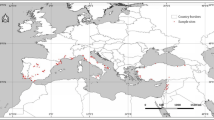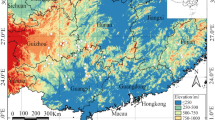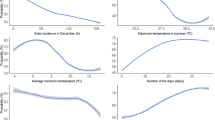Abstract
To assess the potential distribution of Pinus pumila, a dominant species of the Japanese alpine zone, and areas of its habitats vulnerable to global warming, we predicted potential habitats under the current climate and two climate change scenarios (RCM20 and MIROC) for 2081–2100 using the classification tree (CT) model. The presence/absence records of P. pumila were extracted from the Phytosociological Relevé Database as response variables, and five climatic variables (warmth index, WI; minimum temperature for the coldest month, TMC; summer precipitation, PRS; maximum snow water equivalent, MSW; winter rainfall, WR) were used as predictor variables. Prediction accuracy of the CT evaluated by ROC analysis showed an AUC value of 0.97, being categorized as “excellent”. We designated Third Mesh cells with an occurrence probability of 0.01 or greater as potential habitats and further divided them into suitable and marginal habitats based on the optimum threshold probability value (0.06) in ROC analysis. Deviance weighted scores revealed that WI was the largest contributing factor followed by MSW. Changes in habitat types from the current climate to the two scenarios were depicted within an observed distribution (Hayashi’s distribution data). The area of suitable habitats under the current climate decreased to 25.0% and to 14.7% under the RCM20 and MIROC scenarios, respectively. Suitable habitats were predicted to remain on high mountains of two unconnected regions, central Honshu and Hokkaido, while they were predicted to vanish in Tohoku and southwestern Hokkaido. Thus P. pumila populations in these regions are vulnerable to climate change.











Similar content being viewed by others
References
Armonies W, Reise K (2003) Empty habitat in coastal sediments for populations of macrozoobenthos. Helgol Mar Res 56:279–287
Beckage B, Osborne B, Gavin DG, Pucko C, Siccama T, Perkins T (2008) A rapid upward shift of a forest ecotone during 40 years of warming in the Green Mountains of Vermont. Proc Natl Acad Sci USA 105:4197–4202. doi:10.1073/pnas.0708921105
Berry PM, Dawson TP, Harrison PA, Pearson R, Butt N (2003) The sensitivity and vulnerability of terrestrial habitats and species in Britain and Ireland to climate change. J Nat Conserv 11:15–23. doi:10.1078/1617-1381-00030
Braun-Blanquet J (1964) Pflanzensoziologie Grundzuge der Vegetationskunde, 3 Aufl. Springer-Verlag, Wien, New York, p 865
Clark LA, Pregibon D (1992) Tree-based models. In: Chambers JM, Hastie TJ (eds) Statistical models in S. Wadsworth & Brooks/Cole advanced books & software. Pacific Grove, California, pp 377–419
Dirnbock T, Dullinger S, Grabherr G (2003) A regional impact assessment of climate and land-use change on alpine vegetation. J Biogeogr 30(3):401–417
Dullinger S, Dirnböck T, Grabherr G (2003) Patterns of shrub invasion into high mountain grassland of the northern Calcareous Alps, Austria. Arct Antarct Alp Res 35:431–441. doi:10.1657/1523-0430(2003)035[0434:POSIIH]2.0.CO;2
Dullinger S, Dirnböck T, Grabherr G (2004) Modelling climate change-driven treeline shifts: relative effects of temperature increase, dispersal and invisibility. J Ecol 92(2):241–252. doi:10.1111/j.0022-0477.2004.00872.x
Efron B (1979) Bootstrap methods: another look at the jackknife. Ann Stat 7(1):1–26. doi:10.1214/aos/1176344552
ESRI (2005) ArcGIS desktop 9.1. Redlands, Environmental Systems Research Institute, Ins, California, USA
Fielding AH, Bell JF (1997) A review of methods for the assessment of prediction errors in conservation presence/absence models. Environ Conserv 24(1):38–49. doi:10.1017/S0376892997000088
Geographical Survey Institute (2000) Digital map 50 m grid (elevation). Geographical Survey Institute, Tsukuba, Ibaraki, Japan
Hayashi Y (1954) The natural distribution of important trees, indigenous to Japan. Conifers report 3. Bulletin of the forestry and forest product research institute, vol 57, 174 pp (in Japanese with English summary)
Horikawa Y (1972) Atral of the Japanese flora I. Gakken, Tokyo
Huntley B, Berry PM, Cramer W, McDonald AP (1995) Modelling present and potential future range of some European higher plants using climate response surfaces. J Biogeogr 22:967–1001. doi:10.2307/2845830
Iizumi T, Nishimori M, Yokozawa M (2008) Combined equations for estimating global solar radiation: projection of radiation field over Japan under global warming conditions by statistical downscaling. J Agric Meteorol 64(1):9–23. doi:10.2480/agrmet.64.9
IPCC (2001). In: MaCarthy MM, Canziani OF, Leary NA, Dokken DJ, White KS (eds) Climate change 2001: impacts, adaptation and vulnerability. Contribution of working group II to the third assessment report of the intergovernmental panel on climate change. Cambridge University Press, Cambridge, UK, 1032 pp
IPCC (2007a) In: Solomon S, Qin D, Manning M, Chen Z, Marquis M, Averyt KB, Tignor M, Miller HL (eds) Climate change 2007: the physical science basis. Contribution of working group I to the fourth assessment report of the intergovernmental panel on climate change. Cambridge University Press, Cambridge, UK and New York, USA, 996 pp
IPCC (2007b) In: Parry ML, Canziani OF, Palutikof JP, Linden PJ, Hanson CE (eds) Climate change 2007: impacts, adaptation and vulnerability. Contribution of working group II to the fourth assessment report of the intergovernmental panel on climate change. Cambridge University Press, Cambridge, UK, 976 pp
Iverson LR, Prasad AM (1998) Predicting abundance of 80 tree species following climate change in the eastern United States. Ecol Monogr 68:465–485
Iverson LR, Schwartz MW, Anantha MP (2004) Potential colonization of newly available tree-species habitat under climate change: an analysis for five eastern US species. Landscape Ecol 19:787–799. doi:10.1007/s10980-005-3990-5
Japan Map Center (1998) Numerical map user guide, 2nd version. Japan Map Center, Tokyo, Japan (in Japanese)
Japan Meteorological Agency (1960) A method of estimating monthly mean temperature. Technical report of the Japan Meteorological Agency 2:1–9
Japan Meteorological Agency (1996) Climate normals for Japan. Japan Meteorological Agency, Tokyo, JP (in Japanese)
Japan Meteorological Agency (2002) Mesh climate data of Japan. Japan Meteorological Agency, Tokyo, JP (in Japanese)
Japan Meteorological Agency (2004) MRI-RCM20. Global Environment and Marine Department of Japan Meteorological Agency, Tokyo, Japan
Japan Meteorological Agency (2005). Global Warming Projection vol. 6, Japan Meteorological Agency, Tokyo, Japan
K-1 model developers (2004). In: Hasumi H, Emori S (eds) K-1 coupled model (MIROC) descripution K-1 technical report no. 1. Center for Climate System Research University of Tokyo, Japan
Khomentovsky PA (2003) Ecology of the Siberian dwarf pine (Pinus pumila (Pallas) Regel) on Kamchatka (general survey). Science Publishers Inc., Enfield, New Hanmpshire, USA
Kira T (1977) A climatological interpretation of Japanese vegetation zone. In: Miyawaki A, Tuexen R (eds) Vegetation science and environmental protection. Maruzen, Tokyo, pp 21–30
Kominami Y, Tanaka N, Endo Y, Niwano S (2005) Estimation of snow distribution under global warming using data from remote weather stations (AMeDAS). J Agric Meteorol 60:445–450
Lenoir J, Gegout JC, Marquet PA, Ruffray P, Brisse H (2008) A significant upward shift in plant species optimum elevation during the 20th century. Science 320(5884):1768–1771. doi:10.1126/science.1156831
Masuzawa T (1995) Successional process on Mt. Fuji: from alpine herbaceous perennials to dwarf scrub. In: Box EO (ed) Vegetation science in forestry. Kluwer, Netherlands, pp 423–431
Mathematical Systems Inc (2002) S-PLUS 6 for windows user’s guide. Mathematical Systems Inc, Japan
Matsui T, Nakaya T, Yagihashi T, Taoda H, Tanaka N (2004a) Comparing the accuracy of predictive distribution models for Fagas crenata forest in Japan. Jpn J For Environ 46:93–102
Matsui T, Yagihashi T, Nakaya T, Taoda H, Yoshinaga S, Daimaru H, Tanaka N (2004b) Probability distributions, vulnerability and sensitivity in Fagus crenata forests following predicted climate changes in Japan. J Veg Sci 15:605–614. doi:10.1658/1100-9233(2004)015[0605:PDVASI]2.0.CO;2
Matsui T, Yagihashi T, Nakaya T, Tanaka N, Taoda H (2004c) Climatic controls on distribution of Fagas crenata forests in Japan. J Veg Sci 15:57–66. doi:10.1658/1100-9233(2004)015[0057:CCODOF]2.0.CO;2
Mcpherson JM, Jetz W, Rogers DJ (2004) The effects of species’ range sizes on the accuracy of distribution models: ecological phenomenon or statistical artifact? J Appl Ecol 41:811–823. doi:10.1111/j.0021-8901.2004.00943.x
Metz CE (1978) Basic principles of ROC Analysis. Semin Nucl Med 8:283–298. doi:10.1016/S0001-2998(78)80014-2
Ministry of Environment (1999) The dataset for GIS on the Natural Environment, Japan (ver. 2). Ministry of Environment, Tokyo, Japan
Miyaji N (1988) History of younger Fuji Volcano. J Geol Soc Jpn 94(6):433–452 (in Japanese with English summary)
Natori T (2006) Impacts of global warming on alpine plants growing in the Japanese alpine zone and possibility of monitoring global warming impacts with alpine vegetation. Glob Environ Res 10(2):161–166
Nogami M (1994) Thermal condition of the forest vegetation zones and their potential distribution under different climates in Japan. J Geog 103(7):886–897 (in Japanese with English summary)
Ohta S, Kimura A (2007) Impacts of climate changes on the temperature of paddy waters and suitable land for rice cultivation in Japan. Agric For Meteorol 147:186–198. doi:10.1016/j.agrformet.2007.07.009
Okitsu S (1985) Consideration on vegetational zonation based on the establishment process of a Pinus pumila zone in Hokkaido, northern Japan. Jpn J Ecol 35:113–121 (in Japanese with English summary)
Okitsu S, Ito K (1989) Conditions for the development of the Pinus pumila zone of Hokkaido, northern Japan. Vegetatio 84:127–132. doi:10.1007/BF00036513
Pearson RG, Dawson TP, Liu C (2004) Modelling species distribution in Britain: a hierarchical integration of climate and land cover data. Ecography 27:285–298. doi:10.1111/j.0906-7590.2004.03740.x
Powell M, Accad A, Shapcott A (2005) Geographic information system (GIS) predictions of past, present habitat distribution and areas for re-introduction of the endangered subtropical rainforest shrub Triunia robusta (Proteaceae) from south-east Queensland Australia. Biol Conserv 123:165–175
Robertson EA, Zweig MH, Vansteirteghem AC (1983) Evaluating the clinical efficacy of laboratory tests. Am J Clin Pathol 79(1):78–86
Swets JA (1988) Measuring the accuracy of diagnostic systems. Science 240:1285–1293. doi:10.1126/science.3287615
Tanaka N, Matsui T, Yagihashi T, Taoda H (2006) Climatic controls on natural forest distribution and predicting the impact of climate warming: especially referring to buna (Fagus crenata) forests. Glob Environ Res 10(2):151–160
Tanaka N (2007) PRDB (Phytosociological Relevé Data Base). Environment change impact team, Forestry and Forest Products Research Institute. Available at http://www.ffpri.affrc.go.jp/labs/prdb/index-e.html. Accessed Aug 2008
Thuiller W, Araújo MB, Lavorel S (2003) Generalized models vs. classification tree analysis: predicting spatial distributions of plant species at different scales. J Veg Sci 14:669–680. doi:10.1658/1100-9233(2003)014[0669:GMVCTA]2.0.CO;2
Tsuyama I, Matsui T, Ogawa M, Kominami Y, Tanaka N (2008) Habitat prediction and impact assessment of climate change on Sasa kurilensis in eastern Honshu, Japan. Theory and application of GIS 16(1):11–25 (in Japanese with English summary)
Yokozwa M, Goto S, Hayashi Y, Seino H (2003) Mesh climate change impacts in Japan under the gradually increasing atmospheric CO2 concentration. J Agric Meteorol 59:117–130
Yonekura K, Kajita T (2003) BG Platns wamei-gakumei (Japanese–Latin) index (YList). Available at http://www.bg.s.u-tokyo.ac.jp/bgplants/ylistmain.html. Accessed August 2008
Zweig MH, Campbell G (1993) Receiver-operating characteristic (ROC) plots: a fundamental evaluation tool in clinical medicine. Clin Chem 39:561–577
Acknowledgements
We would like to thank Daimaru H, Kajimoto T, Saito S and Nakazono E for their useful comments on an earlier version of the manuscript. This study was funded by the Global Environmental Research of Japan (S-4) program, the Ministry of the Environment.
Author information
Authors and Affiliations
Corresponding author
Rights and permissions
About this article
Cite this article
Horikawa, M., Tsuyama, I., Matsui, T. et al. Assessing the potential impacts of climate change on the alpine habitat suitability of Japanese stone pine (Pinus pumila). Landscape Ecol 24, 115–128 (2009). https://doi.org/10.1007/s10980-008-9289-5
Received:
Accepted:
Published:
Issue Date:
DOI: https://doi.org/10.1007/s10980-008-9289-5




